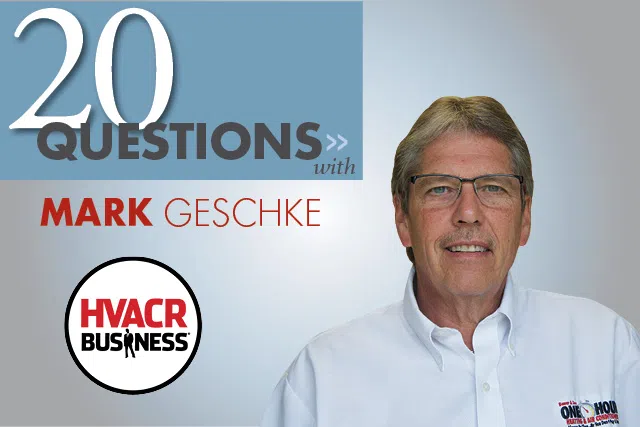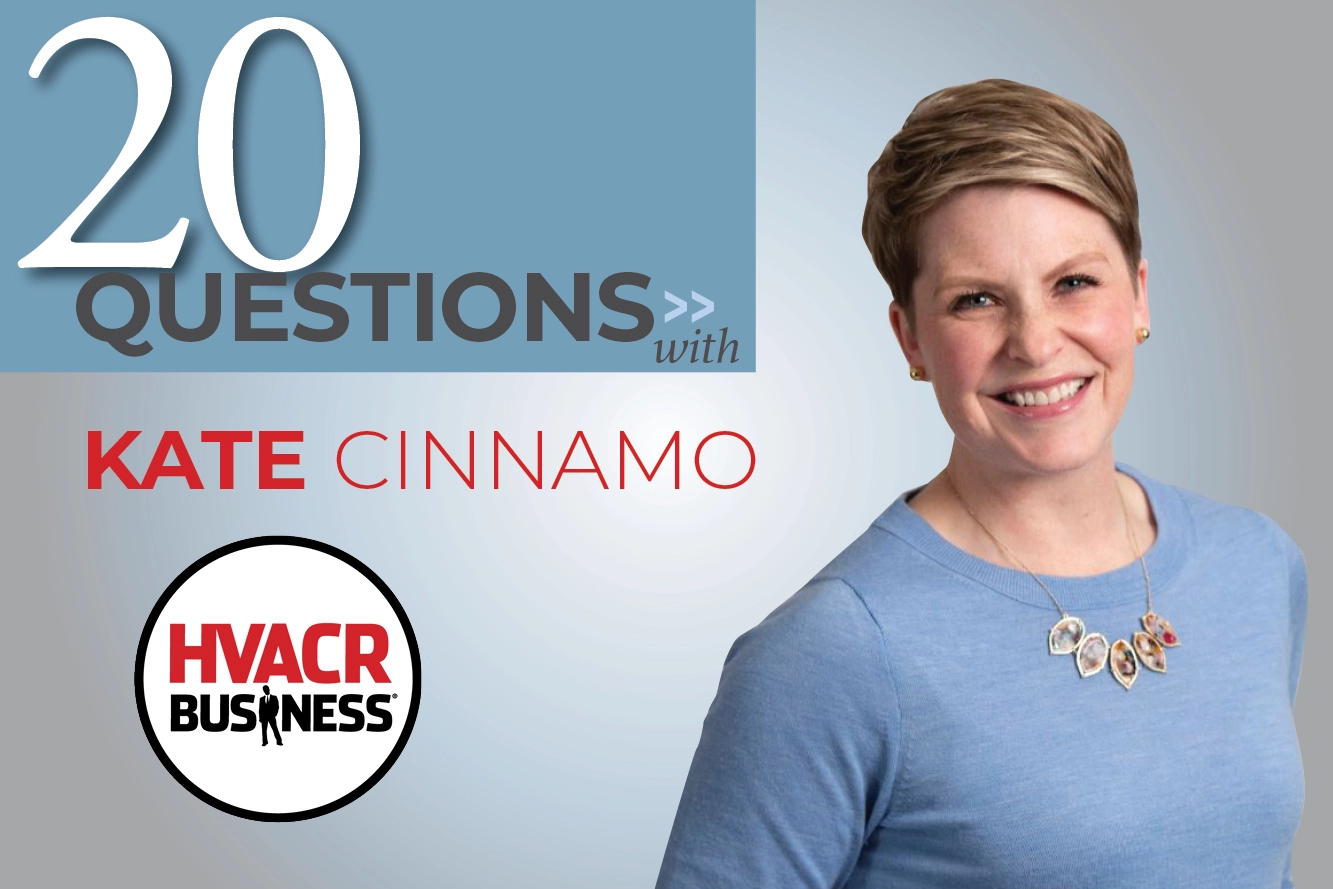We sat down with Mark Geschke, owner of Bauer & Son One Hour Heating & Air Conditioning in Medina, Ohio. Geschke discussed purchasing a business, joining a franchise group and the importance of giving back to the community.
1. Can you tell us a little about your background?
I was a certified wielder in the Navy. When I got out of the Navy back in the mid 70s, things were not that great around here, so I’d work for a while then get laid off. So, I moved to Texas and got a job out there for a while before coming back to Ohio.
2. How did you get started in this industry?
I used my VA benefits to go to computer repair school, because that was the up and coming thing. I was hired by a company that did electronics, they said. It turns out, they were an energy management company that did heating and air conditioning.
3. How long did you work there?
I worked with them for about 10 years, working my way up to Service Manager. Then, in 1992, they ran out of business and closed. That’s when I decided to start my own company.
4. What was it like when you first started?
I figured I couldn’t do any worse than the company I worked for that closed. I did a program with First Energy Ohio Edison installing hot water tanks for a little over a year. While I was in customers’ homes, I put stickers on their furnaces and that’s how I built my customer base.
5. Was it just you those first few years?
It was me and another guy who worked for me. At the time, it didn’t seem that bad … we’d get up and start at 7 a.m. and work until 7 p.m. Then I’d come home and work on blueprints in the basement for new houses we were going to be doing. It was a lot of hours. I was the service manager, the installer, the service guy and the CEO. Barbara, my wife, also worked with us in the beginning as office support.
6. How long before you really started to grow?
Probably in the second year. In this business, it’s easy to start doing new construction work, so we got into that and started talking to builders. At that point, we hired two more people … my brother, who just graduated high school and was going to college, and another guy who had industry experience.
7. So it really started to work out for you?
Yes. By 2000, we’d had steady growth and were in a position to purchase another company here in town. Bauer & Son had been around since 1932. The owner was in his late 60s and ready to retire.
8. How was that purchase a good fit?
We did mostly new construction, which are typically six-month jobs. It strings the money out and you don’t make a whole lot of profit in new construction. Bauer & Son did strictly residential service and replacement. It was a great opportunity to diversify our business and break into the replacement and service world.
9. How did you decide to join up with One Hour?
At the time, we were involved with a company called Air Time 500, which was a precursor to the One Hour franchise. We worked with them for a couple of years when they started talking about the franchise model. A lot of companies were joining up as an exit strategy.
10. What do you mean by that?
Originally, everybody got into the franchise as a way to get out. It was easier to sell your company as a franchise in the future if you wanted to get out. That’s changed over the years, obviously, as the franchise company isn’t really into buying companies.
11. But you’ve stuck with One Hour, even though you’re not looking to get out?
Yes, it’s been a great support system for us and we get a lot of value out of it. We were franchise number eight for One Hour and have been with them for 15 years now, after renewing again just a few years ago.
12. So, what’s your exit strategy?
I’ve got a five-year plan. My brother is general manager now, so we’ll work something out as he starts to take control of the company and, eventually, I’ll just own a small percentage and retire on my way out the door.
13. What is your management style?
I like to consider myself an open book type of manager, a walk around manager. I don’t like to sit in the office. I’ll go and see how people are doing. We’re definitely open door. We share everything with our employees. I treat our employees like I would want to be treated. I love my job. I think all our people like their jobs.
14. How do you motivate your people?
By not sitting up in a closed office … I’m open to people and talk to them. We send out birthday and anniversary cards to all our employees and their families. We keep our family together. Right now, we have an awesome crew of people and we spend more time together, probably, than we do with our real families on a regular basis. We have a great benefit package and we take care of our people with retirement and disabilities and hospitalization. We’re paying for the entire family.
15. What’s recruitment like in your area?
That’s probably one of the toughest things that we deal with on a daily basis, if you will. We are fortunate enough to have an actual recruiter on staff in our office. This gentleman has been doing recruiting for a number of years. He’s also one of our dispatchers, but he’s recruiting for us and for a few locations throughout the country.
16. How did you get started helping out with Children’s Miracle Network?
About five years ago, One Hour was looking for a charity of choice to get behind and promote. They had chosen Children’s Miracle Network, which coincided with what I had been doing for a number of years volunteering with different groups that assisted disabled children.
17. So it was a charity that hit home for you?
Yes. My wife and I had a granddaughter born back in December of 1997; she was only one pound, 10 ounces. And she was up at the Cleveland Children’s Hospital in the NICU for five months. Unfortunately, she didn’t make it. But, just going up there on a daily basis and seeing what those NICU nurses and people had to deal with to make a NICU operate really touched me.
18. How did you get involved with Akron Children’s Hospital?
We shut the company down one day and took everybody down to Akron Children’s Hospital to show them what we were going to get involved with. At that point, I was still in a position where I didn’t have a whole lot of day-to-day duties, so I could really take whatever days I wanted. Mondays were normally my day off, so I figured I’d go down there personally and volunteer every week. And I’ve been there ever since.
19. And now the whole company is involved?
We’re actually one of the first organizations in Children’s Miracle Network to have asked for donations in-house, in the homes of customers. A lot of bigger companies, like Wal-Mart, ask for donations in their retail locations. Over the years, with different campaigns, we’ve probably raised two to three thousand dollars at a time just by asking our customers for help.
20. How do your employees feel about doing so much charity work?
They’re excited about it. They love to participate. That’s one of the reasons I wanted to take everybody to the hospital. I didn’t want to simply say, ‘We’re going to start raising money for Akron Children’s Hospital.’ We actually showed them … here are the different departments, here’s what this money’s going to do. That kind of thing.






